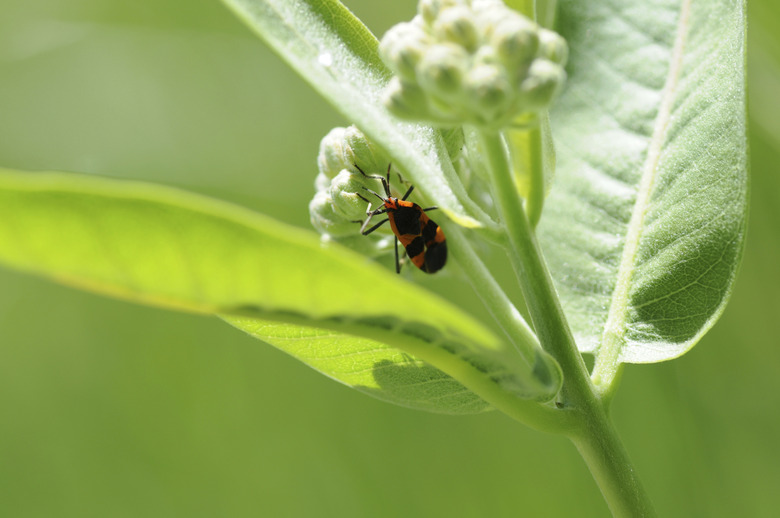Red Bugs On Flower Stems
With their colorful displays and fragrant scents, flowers attract all kinds of creatures. They may be pests, or pollinators or just incidental travelers resting under the petals. Red bugs on the stems could cause damage to the overall plant, while others might be helping it. Proper identification of creatures on the stems will help you decide if your plants need pest control measures.
Step 1
Bugs with red coloring are not necessarily true red bugs. Red bugs (Pyrrhocoridae), also known as stainers, are brightly colored, elongated oval shaped bugs common in southern states. A recent introduction from Europe, the Mediterranean red bug (Scantius aegyptius) has become invasive in California, sometimes amassing in large congregations. Their nymphs are bright red, while the adults, which grow to 1/4-inch long, have red wings with black markings. Red bugs are plant feeders, using their piercing mouth parts to suck the sap from plants and developing seeds. Shake infested flowers over a bucket of soapy water, or pick off the bugs manually.
Spider Mites
Step 1
Tiny, red creatures along flower stems might not be bugs, but could be spider mites (Tetranychidae). These eight-legged cousins of spiders feed on plant tissue by sucking out the sap. Their feeding causes a speckled discoloration on leaves and stems. Spider mites favor dry conditions. Water hardscaping to minimize dust and keep the garden moist to deter spider mites. Natural predators, such as lady beetles and predatory mites, help reduce spider mite populations. A jet of water from the garden hose will remove mites from flower stems.
Step 2
- Bugs with red coloring are not necessarily true red bugs.
- Red bugs are plant feeders, using their piercing mouth parts to suck the sap from plants and developing seeds.
Red Aphids
Step 1
Some species of plant-feeding aphids appear pink or red. These small, pear-shaped pests feed on a variety of plants, causing leaf stippling, curling and stunted plant growth. Spray water forcefully to remove aphids from plants. Encourage natural aphid predators, such as ladybugs and parasitic wasps, into your garden by avoiding the use of insecticides. Apply insecticidal soap, available from garden centers in spray form, over all plant surfaces where aphids are present and predators are lacking. Shake the bottle well before spraying and apply in early morning or late afternoon when temperatures are less extreme. Repeat the application every 5 to 7 days as needed.
Step 2
- Some species of plant-feeding aphids appear pink or red.
- Apply insecticidal soap, available from garden centers in spray form, over all plant surfaces where aphids are present and predators are lacking.
Lily Leaf Beetles
Step 1
Bright red beetles, about 1/2-inch long, on flower stems could be lily leaf beetles (Liliocerus lilii) preparing to lay eggs. Females deposit eggs on the underside of flowering plant leaves. Adults and larvae feed on foliage and flowers. Handpicking beetles off flower stems is usually enough to control their populations and prevent severe damage to your plants. Drop the beetles into a bucket of soapy water to kill them.
Beneficial Red "Bugs"
Step 1
Red bugs on flower stems aren't necessarily pests. Red velvet mites (Thrombidiidae spp.) are 1/4-inch long arachnids with red velvety bodies. These creatures are helpful around the garden, eating grasshoppers, beetles and other plant-eating pests. Another helpful red insect is the familiar ladybug. Adult and larval ladybugs have voracious appetites for plant-sucking aphids.
Step 2
- Bright red beetles, about 1/2-inch long, on flower stems could be lily leaf beetles (Liliocerus lilii) preparing to lay eggs.
